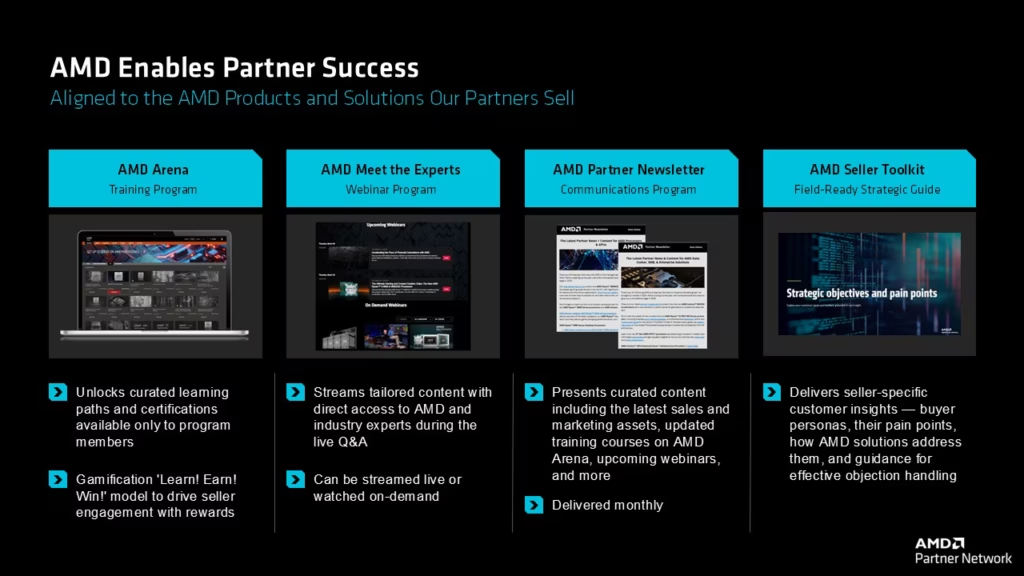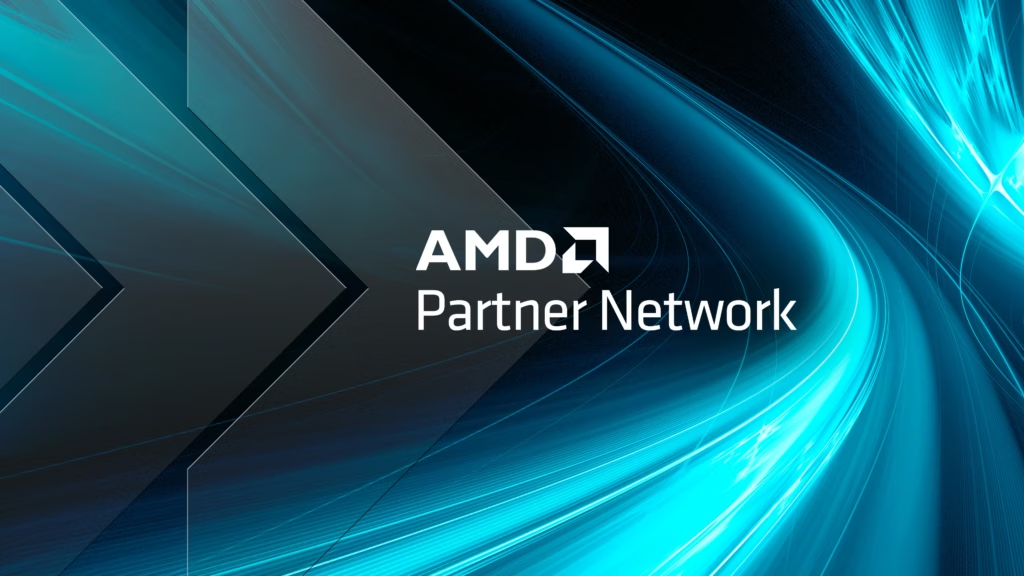AMD has announced a significant update to its global channel program, now called the AMD Partner Network (APN). The goal: centralize training, business enablement, go-to-market tools, and incentives for OEMs, distributors, VARs, and domestic solution providers, aiming to accelerate adoption of its catalog — from Ryzen™ and Threadripper™ for clients to EPYC™ and AI accelerators in data centers — with a more coordinated sales and marketing ecosystem.
The company accompanies this reorganization with a 40% year-over-year increase in channel investment and the activation of 520 partners across its client, cloud, and server portfolios. AMD emphasizes that APN is not “just another portal,” but a strategic piece to extend to partners the momentum it has gained since 2017 in market share and revenue growth.
What changes with APN: a single “hub” and membership levels
1) Central repository
APN will focus all resources in one destination:
- Training (through AMD Arena program), webinars Meet the Experts, and a seller toolkit with messaging frameworks and advanced resources segmented by buyer profiles.
- Enablement and go-to-market: guides, playbooks, battlecards, marketing assets, and messaging ready to be integrated into OEM and reseller campaigns.
- Operations and incentives: dashboards to monitor and manage rebates, promotions, and performance metrics.
2) Certification on demand
Participants can complete learning paths by curriculum, with a la carte exams and the ability to obtain certificates and badges that can be shared on LinkedIn. The idea is to update skills with less friction and demonstrate competencies to clients.
3) Levels and benefits
The program provides a common foundation for all and levels such as Silver, Gold, and Platinum, offering incremental benefits: co-marketing, early access to strategic initiatives, and enhanced support. AMD suggests that progression will be linked to training, specialization, and results.

Why it matters: from hardware to well-orchestrated solution selling
AMD recognizes that chips are only “half the equation” for channel success. Value is created when hardware, software, and services are bundled with a clear business message and delivered to the right customer with timely responses and a consistent experience. In this context:
- For OEMs, APN facilitates alignment of messaging and marketing assets with platform launches and roadmaps, or integration of materials into their own portals.
- For VARs, distributors, and NSPs, the platform aims to reduce fragmentation (multiple sources, versions, ppts in folders) and provide actionable training by vertical and use case (e.g., refreshing workstations, consolidating data centers, generative AI, VDI, edge computing).
- For ISVs and developers, co-development resources (software optimization on CPU/GPU/AI) and technical evangelization are better linked with the commercial message at the end user.
AMD frames this move within the sector’s evolution: over the past decade, co-optimization of HW/SW has been consolidated; now, the challenge is to extend that alignment to the final mile of the sales process, so that the technical value is packaged as an understandable and quantifiable solution.
Training and enablement: from “speeds & feeds” to ROI conversations
Historically, many channel programs focused on features (cores, GHz, TDP) without translating them into operational benefits. APN emphasizes:
- Business cases tailored to industries (finance, healthcare, manufacturing, public sector, retail), with frameworks to discuss TCO/ROI (performance per watt, license consolidation, energy savings, green bidding).
- Competency guides that are well-documented and regularly updated, supporting technical and pre-sales sales.
- Practical journeys: from opportunity detection and qualification to closing, with toolkits for POCs, benchmarks, and references.
The APN certification aims to ensure partners’ teams not only understand the technology but also know how to position (and defend) it in buying committees.
Incentives and visibility: less “guessing,” more “measuring”
APN will integrate tools for:
- Incentive management (real-time tracking of rebates, spiffs, and marketing development funds).
- Dashboards and dashboards with KPIs on pipeline, win/loss, solution mix, and training activity.
The declared goal of AMD is to reduce administrative friction and enable partners to better measure which tactics work by country, vertical, or customer type.
The context: a decade of momentum and a transitioning market
Since 2017, AMD has experienced strong growth in CPUs (Ryzen™, EPYC™, Threadripper™) and has expanded its reach in GPU and AI accelerators — a portfolio spanning from PCs and workstations to hyperscale. Meanwhile, the channel has seen:
- Refresh cycles focused on efficiency and local AI.
- Data centers migrating workloads to cloud, colocation, and hybrid on-prem, with an emphasis on performance per watt and consolidation.
- The rise of generative AI and the pursuit of multi-vendor platforms to avoid lock-in and optimize cost/performance.
The shift to APN aims to capitalize on this momentum with a more robust and synchronized commercial ecosystem.
What partners can expect (by profile)
OEMs
- Ready assets for co-branding, launch calendars, technical and commercial briefings.
- Joint campaigns and visibility programs with clear criteria.
Distributors
- Training materials to scale knowledge within reseller networks.
- Improved forecasting and incentives supported by metrics and evidence.
VARs / NSPs / integrators
- Certification paths by solution (client, server, AI, edge).
- Playbooks for verticals (healthcare, industrial, finance, public sector).
- Support for POCs and competitive references.
Consultants / Advisory
- Toolkits for evaluations and RFP/RFQ with approaches focused on TCO/ROI and ESG requirements.
- Materials for investment committees and technical due diligence.
Getting started with AMD Partner Network
- Registering on the APN portal and mapping internal profiles (sales, pre-sales, marketing, technical).
- Selecting the entry tier (all members receive a common base; Silver/Gold/Platinum tiers offer scaled benefits).
- Training plan: choose paths by line of business (client, server, cloud/AI), complete certifications, and on-demand exams.
- GTM activation: download assets, align campaigns, and if appropriate, request co-marketing.
- Incentives and metrics: set up dashboards, define KPIs, and review routines.
Signals to watch (coming months)
- New certification paths specific to AI and accelerated platforms.
- Integration of APN assets into OEM and distributor portals.
- Success stories with KPIs on pipeline and revenue attributable to APN.
- Refinement of incentives by vertical and outcome (not just volume).
In summary
With AMD Partner Network, the company aims to raise the bar for its commercial ecosystem: a single repository of training and resources, flexible certification, visible incentives, and co-marketing that extends the HW/SW co-optimization into the sales front. For partners integrating PCs, servers, cloud, or AI solutions, APN promises less friction, better enablement, and a more consistent value message to the end customer. AMD, meanwhile, commits to increased investment and requests in return training commitment and results-oriented focus.

